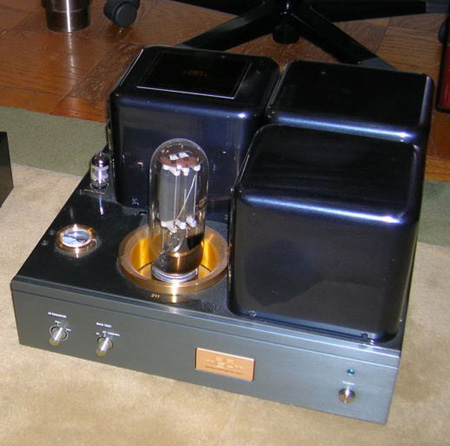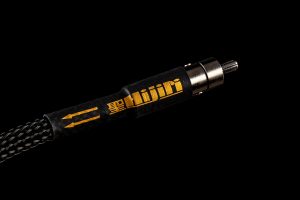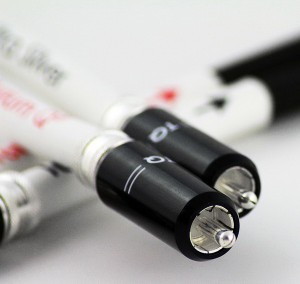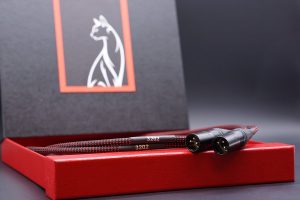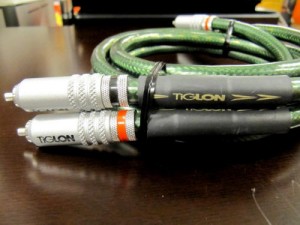Let's go skinny dipping... with an impressive leap in cabling technology!
With this article, Positive Feedback continues its content-sharing relationship with Enjoy the Music. Paul L. Schumann shares his thoughts on the Kimber Kable Naked Interconnects.
Dr. David W. Robinson, Editor-in-Chief
Ok, we've all done it. We've swum in the water in our birthday suits. It may have been in a swimming pool, maybe in a lake or stream, maybe even in the ocean. I don't want to know your details, and I'm sure you don't want to know mine. But one way or another, we got naked outside and took the plunge. And no matter the outcome, it was a memorable experience. Such as with the Kimber Kable Naked Interconnects.
My familiarity with Kimber Kable goes back further than I like to admit. Back then I was still a novice to the world of high-end interconnects. It was 1997 and I just upgraded my CD player. When I got it home and plugged it into my system, my wife and I noticed that it didn't sound right. The tonal quality was pinched, and it sounded nothing like it did in the showroom of the audio salon where I bought it. When I went back, they asked me what interconnects I was using. I won't mention the name, but it was a brand you can still find in big-box stores today.
When I told the salesperson what I had, he screwed up his face for a moment, and then said, "I have something you should try." He sent me home with two pairs of interconnects: Kimber Kable PBJs and a Kimber Kable Silver Streaks. When I got back home, I got the what-the-heck-did-you-buy-now look from my wife. I assuaged her concern by telling her they were loaners. First, we tried the PBJs and noticed a tremendous improvement over the ones I had been previously using. Then we tried the Silver Streaks and it was, for lack of a better word, magic. The engagement level had just been bumped up several notches. If we had not been listening together, I would have thought I was delusional. Needless to say, we bought the Silver Streaks and still have them today.
Something New... And Special!
Fast-forward to this year and I am looking for something special to review. I notice that Kimber Kable announced their new Naked interconnects. I also noticed their price. I send an email to Steven, joking about reviewing them. He forwards me to Nate of Kimber Kable. When I talk to Nate on the phone I explain my system to him, doubting if I should be reviewing such an elite item. But Nate insists, and soon two pairs are headed my way.
So what makes the Naked interconnects so different? Well, the Naked name is kind of a giveaway. Of course, if you have a wire and want to conduct a current through it, you need to insulate it so you don't short to ground. In audio system terms, that means without an insulator, the audio signal would never reach its destination. So, you have to have an insulator. But here is where it gets interesting. If you took physics, you remember that whenever a wire conducts electricity, it generates an electromagnetic field. This field induces a charge in whatever material is near the wire. The problem is, the insulator then quickly releases that charge back into the wire. This causes smearing of the signal. The property of a substance to absorb and release this charge is called its dielectric constant. The higher the dielectric constant, the more it absorbs the electromagnetic charge, then releases it.
If you are deciding on a material to put in the middle of a capacitor, that's a good thing. But if you want to maintain the integrity of a music signal, you want it as low as possible. The lowest value is 1, which is air (or a vacuum if you happen to live in outer space). Most insulators range from 2 to 5. But unless you can magically levitate your wires everywhere, you are going to need some sort of insulator. It turns out that good old fashioned cotton has a dielectric constant of 1.33, which is pretty darn close to air. So that's what Kimber Kable used. But it's not ordinary cotton, it's unwaxed organic cotton. That way there are no impurities. But if you use cotton as an insulator, that raises a problem. Cotton is porous, letting in air and moisture. This makes it poor at minimizing corrosion.
The Solution
Kimber Kable's solution to this is to plate 24 karat gold on top of the pure copper conductor strands. Pure gold won't react with anything. Gold and copper easily form a substitutional alloy, so if you plate gold directly on to copper, they will start to combine along the area of contact. To prevent this, the copper is plated with a thick layer of palladium first. Palladium, like gold, is non-reactive, non-magnetic, and malleable. But, it won't form an alloy with either copper or gold, making it a perfect barrier. Quite elegant.
So how is all of this implemented? When you take the Naked interconnects out of the box, you will quickly realize that they are unlike any other interconnects you have ever possessed. Your first question might be, "Where's the wire?" They are so light the impression is you are handing some cotton tubing. Then you notice them. The six golden threads spiral gracefully around the inner core of white cotton. These wires are only 24 AWG! That's 2/100ths of an inch in diameter. These wires are then covered with an open weave of cotton to prevent shorting, but still, show off those beautiful golden conductors. Our fearless leader Steven is a big watch aficionado and I know he would appreciate the fine craftsmanship of these interconnects.
Before I go into the sound, I need to make a little note about connecting these little works of art. Due to their design, they are not very flexible and can kink if you are careless with them. In addition to that, the bejeweled RCA connectors are about 2" long. That means when you're hooking them up, in a tight space, like my stereo cabinet, you need to take your time. For me, that meant drilling some new holes in the back. I have to admit, I did break out into a cold sweat a few times as I snaked these beauties through the labyrinth, but in the end, all was well.
The Sound Of Being Naked
So how do they sound? Let's go back to my skinny dipping analogy since it sums up how I feel about these interconnects. When you first jump in, there is a mix of sensations. First is the heightened sensitivity of the water touching your skin. The Naked interconnects are extremely sensitive components that reveal all the nuances of the music. Listening to Billie Eilish's When We All Fall Asleep, Where Do We Go? [B0029727-02], I was struck by all of the nuances of Finneas' brilliant production. Also, Billie's voice sounded so lush and intimate, like it was recorded in someone's bedroom. Oh, right, it was. Digging deeper, I listened to Lutoslawski's 3rd Symphony performed by Salonen and the LAPO [LC 06868]. This work is a grab-bag of stunning orchestral effects. The Naked interconnects revealed all of their subtleties and the complex interplay of the instruments.
Another sensation of swimming in the water in the buff is one of excitement. Let's face it, you have some parts exposed that are normally covered up. The Naked interconnects brought new excitement to everything I listened to. Sharp transients had more impact. Stravinsky's Concerto for Piano and Wind Instruments [B00C3K9DFS] emphasizes the percussive nature of the piano. The Naked interconnects brought into sharp contrast the jarring dynamics of the piano with instruments of the wind symphony. I could feel every clang viscerally. On Brad Meldau's Art Of The Trio: Volume One [9 46260-2], the dynamics of this intimate recording were mind-boggling, especially Larry Grenadier's powerful bass. It was pretty darn close to having a real live jazz trio in my living room.
Jumping in the water without a stitch, you have a visceral reaction to the temperature. If it's cool like a fresh-water lake, you feel invigorated. If it is warm like the Gulf of Mexico, you immediately relax. If it's cold, like the North Atlantic Ocean, there's a bit of a shock with some shrinkage involved. No matter what the conditions, you are immediately immersed in your surroundings. The Naked interconnect connects you with the emotion of the music in the same way. Let's go back to Stravinsky's Concerto for Piano and Wind Instruments. Stravinsky wrote this as a showpiece for his piano playing and to make some money as a soloist.
As with all of his neo-classical pieces, Stravinsky was emphasizing the objective (rational) aspects of music over the subjective (emotional) aspects. One of the ways he achieved that was the removal of all strings except the double basses. The first movement is almost machine-like in its precision, with all the parts fitting together like an intricate puzzle. It is purely objective. Then in the second movement, Stravinsky lets his guard down a little with what can only be called an enchanting melody. But he doesn't let his guard down too much, since the orchestration around it is quite austere.
In the final movement, he quickly snaps back to the objective with what can be called a frenetic allegro. As the mood of this great work shifted from cool, to slightly warm, then back to cool, the Naked connected me with the emotions of the music.
Of course, as you swim in your birthday suit you become keenly aware of your surroundings. The fear of getting caught heightens one's senses and increases your spatial awareness. The Naked interconnects opened up the soundspace on every recording to which I listened. Take for example Abbado Conducts Mussorgsky [ARL1-3988]. This collection of lesser-known pieces has always been a favorite of mine since, sadly, a great deal of music was ignored because of its fragmented nature. While Abbado and LSO's performances of these pieces are magnificent, the recording from the late 1970s doesn't live up to early RCA Living Stereo standards. In the past, this album has always sounded like it was recorded in a phone booth. While listening to it through the Naked interconnects, the soundscape seriously opened up to the sides and the back. It was a pleasant surprise, to say the least.
Another thing you experience while you're dog-paddling au naturale is a sense of vulnerability. You are exposed to any of the creatures lurking in the depths of the water or to any unwelcome advances by your fellow swimmers. In this case, you, the listener, are not the vulnerable one, but your system. Some cabling is good at smoothing over the rough edges of sound reproduction, but not the Nakeds. If you want to hear the characteristics of your equipment, these are the ones for you. Luckily, I have been able to choose equipment that lacks any sort of hard edge or sounds too "detailed." Such equipment might not be a good fit. As a reviewer, I am regularly swapping out components for review. With the Naked interconnects in place, I was able to immediately detect any differences. In one case, a simple swap of two small-signal tubes made a huge difference in the sound of the system. They are that revealing.
Enjoying A Full Release
A final emotional release of nearly all experience while skinny dipping is guilt. When you're naked out in the open, you are violating a cultural taboo. Also, unless you're a world-class athlete or a Victoria's Secret model, you probably aren't the most comfortable with the looks of your naked body. Similarly, I experienced guilt while reviewing the Naked interconnects. My guilt was out of a feeling of unworthiness. Hey, these cables are top-of-the-line equipment. While I do have a nice system, none of the components in it match the Naked interconnects for elite status. Despite that disparity, I certainly heard the differences they made and my system is better because of them. I feel really lucky to review equipment for Enjoy the Music.com. With the Naked interconnects I feel even luckier.
The Naked interconnects represent an impressive leap in cabling technology. This translates into an audio connection that is highly revealing and adds no coloration to the music. As a reviewer, I appreciate their complete neutrality. As a music lover, I enjoy how they get me closer to the music. Come on in everyone, the water is great. It's awesome to go Naked.
Specifications
- Type: High quality unbalanced RCA analog interconnects
- Dielectric: Cotton
- Conductors: 24AWG solid-core copper plated with a thick layer of palladium, followed by a thick layer of gold.
- Price: $12,700 for one-meter pair
Kimber Kable
2752 S. 1900 W.
Ogden, Utah 84401
801.621.5530
Check out Enjoy the Music for more articles and reviews
















